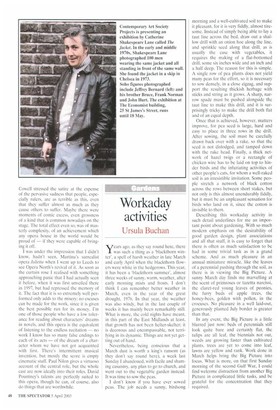Workaday activities
Ursula Buchan
years ago, as they say round here, there was such a thing as a 'blackthorn winter', a spell of harsh weather in late March and early April when the blackthorn flowers were white in the hedgerows. This year, it has been a 'blackthorn summer', almost three weeks of sunny, warm, weather, after early morning mists and frosts. I don't think I can remember better weather in March, even in the year of the great drought, 1976. In that year, the weather was also windy, but in the last couple of weeks it has mainly been remarkably still. What is more, the cold nights have meant, in this part of the East Midlands at least, that growth has not been helter-skelter; it is decorous and encompassable, not terrifying in its dynamic. Things are not yet getting out of hand.
Nevertheless, being conscious that a March dust is worth a king's ransom (as they don't say round here), a week last Sunday I abandoned, with facile and shaming casuistry, any plan to go to church, and went out to the vegetable garden instead. It was time to sow the peas.
I don't know if you have ever sowed peas. The job needs a sunny, birdsong morning and a well-cultivated soil to make it pleasant, for it is very fiddly, almost tiresome. Instead of simply being able to lay a taut line across the bed, draw out a shallow drill with an onion hoe along the line, and sprinkle seed along that drill, as is usually the case with vegetables, it requires the making of a flat-bottomed drill, some six inches wide and an inch and a half deep. The reason for this is simple. A single row of pea plants does not yield many peas for the effort, so it is necessary to sow densely, in a close zigzag, and support the resulting thickish herbage with sticks and string as it grows. A sharp, narrow spade must be pushed alongside the taut line to make this drill, and it is surprisingly tricky to make the drill both flat and of an equal depth.
Once that is achieved, however, matters improve, for pea seed is large, hard and easy to place in three rows in the drill. After sowing, the soil must be carefully drawn back over with a rake, so that the seed is not dislodged, and tamped down with the rake head. Finally, a thick network of hazel twigs or a rectangle of chicken wire has to be laid on top to hinder birds and the infuriating activities of other people's cats, for whom a well-raked soil is an irresistible invitation. Some people stretch a network of black cotton across the rows between short stakes, but not only is this almost unendurably fiddly, but it must be an unpleasant sensation for birds who land on it, since the cotton is invisible to them.
Describing this workaday activity in such detail underlines for me an important point about gardening. With so much modern emphasis on the desirability of good garden design, plant associations and all that stuff, it is easy to forget that there is often as much satisfaction to be had in some trivial task as in a grand scheme. And as much pleasure in an annual miniature miracle, like the leaves of a perennial pushing through the soil, as there is in viewing the Big Picture. A sunny March day finds me marvelling at the scent of primroses or tazetta narcissi, the claret-red young leaves of peonies, the furry buds of apple trees, the honey-bees, golden with pollen, in the crocuses. No pleasure in a well laid-out, generously planted July border is greater than that.
In any event, the Big Picture is a little blurred just now: beds of perennials still look quite bare and certainly flat, the tulips are all leaf, the biennials not out, weeds are growing faster than cultivated plants, trees are yet to come into leaf, lawns are yellow and rank. Work done in March helps bring the Big Picture into focus. What is more, on that first Sunday morning of the second Gulf War, I could find welcome distraction from another Big Picture in complicated little tasks, and be grateful for the concentration that they required.


































































 Previous page
Previous page